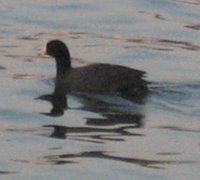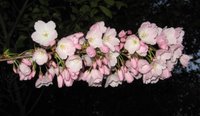 This evening I made my obligatory visit to see the famous cherry trees and do a little birding. The blooming of the cherry trees around the Tidal Basin is one of the annual markers of spring in Washington, DC. The plantings here originated as a gift of 3,020 trees from the City of Tokyo in 1912. The trees are mostly of the Yoshino cherry variety, with several other types mixed in as well. In their peak blooming period, the trees look like they support a delicate snowfall.
This evening I made my obligatory visit to see the famous cherry trees and do a little birding. The blooming of the cherry trees around the Tidal Basin is one of the annual markers of spring in Washington, DC. The plantings here originated as a gift of 3,020 trees from the City of Tokyo in 1912. The trees are mostly of the Yoshino cherry variety, with several other types mixed in as well. In their peak blooming period, the trees look like they support a delicate snowfall. The walkways of the Tidal Basin become packed with pedestrians during the trees' peak blooming period. Even on a weekday evening - generally off-peak for visitors - it was still pretty crowded in places. Since the walkways have no guardrails, this necessitates paying close attention to where the water is and where other people are. This is not good for anyone with a bad sense of balance or with fear of heights. I am surprised that there are not more stories of people falling into the water here.
The walkways of the Tidal Basin become packed with pedestrians during the trees' peak blooming period. Even on a weekday evening - generally off-peak for visitors - it was still pretty crowded in places. Since the walkways have no guardrails, this necessitates paying close attention to where the water is and where other people are. This is not good for anyone with a bad sense of balance or with fear of heights. I am surprised that there are not more stories of people falling into the water here.
But, onto the birds.... I started off my birding by mistaking a great black-backed gull for a bald eagle. I saw the dark wings and white head and tail of the distant bird, and my mind leapt to a more desirable conclusion. My mistaken first impression was soon corrected when I looked at it through my bionculars. One American coot still lingers on the Washington Channel, and a few lesser scaup were in the Potomac. I did not see any of the grebes or other waterbirds that have been reported from this area for the past few weeks. But the spring birds are arriving. Double-crested cormorants continue to pass through in small flocks. At least one osprey was working on the nest on the railroad bridge; I expect a pair will breed there again this year.
One American coot still lingers on the Washington Channel, and a few lesser scaup were in the Potomac. I did not see any of the grebes or other waterbirds that have been reported from this area for the past few weeks. But the spring birds are arriving. Double-crested cormorants continue to pass through in small flocks. At least one osprey was working on the nest on the railroad bridge; I expect a pair will breed there again this year.
Near the DC WWI memorial, I saw several bats swooping in and out of the tree canopy. It was still light enough to get a look with my binoculars. Bats are very hard to track with binoculars - even harder than swifts and swallows because they fly so fast and so erratically. I think these were probably big brown bats. (An inventory of bats on the National Mall in 2003 found big brown bats to be in the vast majority.)
SPECIES SEEN: 17
Double-crested Cormorant
Canada Goose
Mallard
Lesser Scaup
Osprey
American Coot
Killdeer
Ring-billed Gull
Great Black-backed Gull
Rock Pigeon
Mourning Dove
Downy Woodpecker
American Robin
American Crow
European Starling
House Sparrow
Common Grackle
If, like me, you have a distaste for walking in heavy crowds, here are some suggestions for alternate times and locations for seeing cherry trees in the area. Some of them are good birding spots, too.
In the last week or so, a lot of people have come here looking for a "cherry blossom webcam," or something of that sort. If you have come here looking for one, try visiting the National Park Service, which has its own Cherry Blossom Web Camera. There is also a series time-lapse photographs of the flowers blooming provided by the Washington Post.



